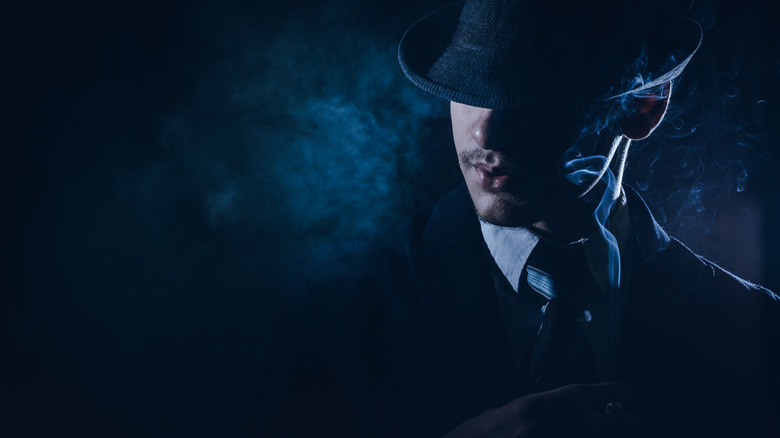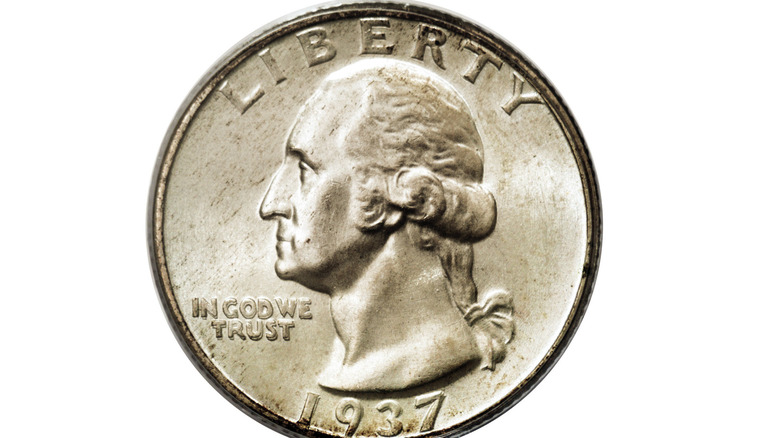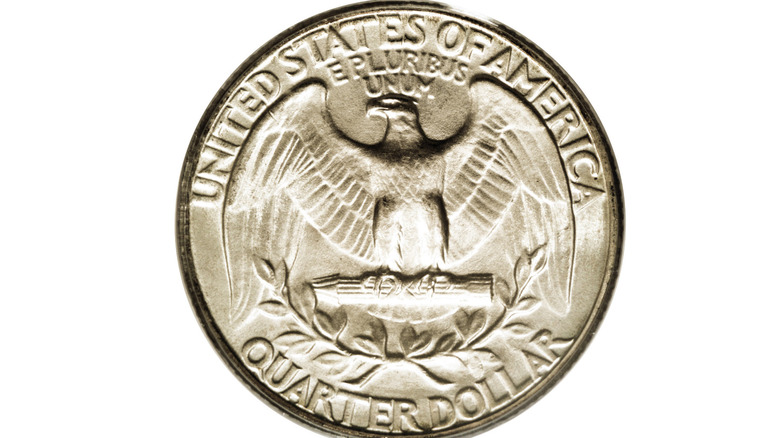A Hard-To-Find Quarter From The 1930s Is Worth A Lot Of Money
If you picture a 1930s gumshoe flipping a quarter in some lonely streetlight to pass the time, chances are, you aren't thinking that quarter is worth a small fortune. But it's true: some old quarters are worth a pretty penny, even if they're not worth quite as much as one of the most expensive pennies still in circulation.
Quarters have been loitering around the currency scene since 1796, when the U.S. Mint first released quarter dollar coins in actual silver. The quarter has undergone many changes to material and design since the horse-and-buggy days to become the copper and nickel alloy (or cupronickel) clad vending machine darlings of today. Much like old timey detectives hunt for clues, coin collectors hunt for certain coins that bear the marks of another time, and even coins missing valuable marks that may be valuable.
The 1937 doubled die obverse Washington quarter is quite collectible, worth much more than chump change. While its name among collectors might be a bit of a mouthful, having a fistful of these very rare quarters — and in Very Fine condition, no less — could mean you're holding quite a bit of cold, hard cash in your hot little hands.
This 1937 quarter is double trouble
Seasoned coin collectors may know how to spot rare and valuable coins, but those new to the numismatic scene might not know that double the die could mean double your money — or sometimes more. Coins referred to as "doubled die" coins indicate a manufacturing error was made at the mint, when the coin was struck. Doubled die coins feature some design element printed on the coin twice, presumably by accident.
Before 1997, coin designs were printed using hot, hot heat applied to coin dies, which are then pressed into secured coins via a nifty coin-press system. This hot die would impress the cool coin design onto the material of the coin, pressing the design on the obverse (heads) and reverse (tails) sides of the coin. Sometimes, during part of the manufacturing process, the coin hub and die would be misaligned, and instead of a cleanly printed and centered coin design, the design image would end up looking overlapped upon itself. This deformed, or doubled die, made a coin with some or all of its design elements to be fully or partially doubled on the pressed coin, creating a trippy, offset effect for images, text, and numbers.
Doubled die coins sometimes didn't end up in circulation, but enough still trickled through. Some doubled die coins are worth about their own face value, and some pretty darn valuable, including the 1937 doubled die obverse Washington quarter.
The 1937 doubled die obverse Washington quarter
1937 was a big year for the United States, and for the doubled die quarter. 1937 saw the start of President Franklin Delano Roosevelt's second presidential term, the Hindenburg disaster, the opening of the Golden Gate Bridge, and the disappearance of Amelia Earhart. It also saw the U.S. Mint strike quarters with a bust of Washington on the obverse side, and the stately American eagle on the reverse. In the doubled die variety of this quarter, "In God we Trust" is given a drop shadow-like effect. There is also a trace of the double-stamping present in the "1937" printed on the obverse side of the coin. Note: these quarters don't always bear a mint mark.
While these surviving quarters tend to be rare, most are in shopworn (or wallet-worn) circulation condition. A low-end, "Good" grade of this coin can be worth around $250 to collectors. Specimens graded Very Fine can be worth around $600. More amateur markets might deal in lower amounts, of course. In November 2024, one quarter in this doubled die bunch sold for the humble pocket change of $110 on eBay. Very rare specimens of the 1937 doubled die obverse Washington quarters may have you itching to solve the mystery of where you can find one. In 2020, one excellent specimen sold at auction for the drop-dead gorgeous sum of $22,250.


